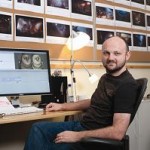Legend of the Guardians: Editor David Burrows
 Editor David Burrows had to keep the heart of the story as his first priority when working on Legend of the Guardians: The Owls of Ga’Hoole.
Editor David Burrows had to keep the heart of the story as his first priority when working on Legend of the Guardians: The Owls of Ga’Hoole.
How do you combine the rhythm expected of an animated epic, and the pace that family films usually employ?
Today’s audiences are very smart, very film-literate – so you’ve got to try and stay ahead of them without ever leaving them behind! At the forefront of my mind when cutting any scene is getting to the heart of the story – and this very much dictated how I would approach any given scene – whether it was an intimate scene involving the family or a full-on battle scene. In Guardians the obvious through line of film is Soren’s story so keeping that front and centre was always the priority.. A good example of this is the scene where he and Gylfie try to escape from St Aggies. Essentially it’s an awesome fight scene followed by an exciting escape chase – but what really makes the scene sing is Soren urging his brother to flee with them – and how Soren responds to what happens.
What was the most complex sequence to put together?


From one editor named David Burrows to another…. terrific job!
kept the heart of the story as his first priority
really?
well done, great job
Maestro! Brilliant work my old friend!
hi dad